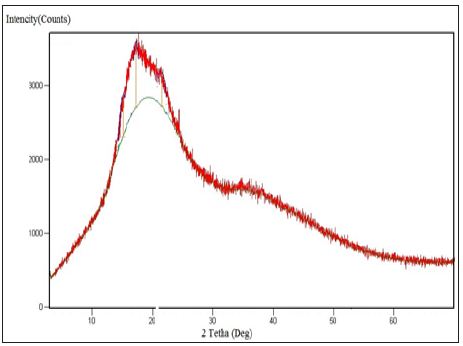Impact Factor : 0.548
- NLM ID: 101723284
- OCoLC: 999826537
- LCCN: 2017202541
Tounsia Aksil-Abbas1*, Moussa Abbas1 and Salem Benamara2
Received: December 12, 2017; Published: December 19, 2017
Corresponding author: Tounsia Aksil-Abbas, Laboratory of Soft Technologies and Biodiversity (LTDVPMB), Faculty of Sciences, University M’hamedBougara of Boumerdès, 35000, Algeria
DOI: 10.26717/BJSTR.2017.01.000607
The fruits of the strawberry tree (Arbutus unedo L.) are consumed mainly as processed product, but may be a good source of antioxidants if consumed as fresh fruit. The presented work aims to evaluet some of its physicochemical parameters, including X-ray diffraction (XRD) properties, crude fiber, titrable acidity, etc.
Keywords: Arbutus unedo L; Caracterisation; Physicochemical
Abbreviations: FA: Arbutus fruit; XRD: X-Ray Diffraction
Arbutus berries (Arbutus unedo L.) is a Mediterranean typical tree which fruit is generally not consumed in fresh form but after processing [1]. Like other plants which are fitted with wonderful defense system assured by various biopharmaceuticals [2], the berries are also known to be used in folk medicine as antiseptic, diuretic and laxative [3] Moreover, Ruiz-Rodríguez et al. [4] having earlier supported that the higher antioxidant potential of the arbutus berries may be due to the activity of various bioactive components including vitamin C. So, considering dietary ingredient any herbal or botanical material containing vitamins and minerals, arbutus berries may be repertories as a dietary supplement. Arbutus unedo (Ericaceae) part of the range of Algeria medicinal plants [5]. The Arbutus fruit (FA) is poorly exploited, not very well-known from point of view nutritional and industrial by the population Algerian and its consumption remains seasonal. In this context, the present work main purpose the physico-chemical study powder freezedried (PL) of Algerian FA (Arbutus unedo L.).
Ripe Arbutus berries were picked in Kabylian region (northern Algeria) in 2017. The fruit is submitted to freeze drying at 109 K (4.5 Pa) during 2 days. The dried product is then ground and sieved (sieve of type Euromatest-Sintoo, NFX11-501) to obtain homogeneous powder (LP) which is kept in closed glass flask at 277K. The general chemical parameters of LP A. unedo berries, namely; crude fiber [6], titrable acidity (with NaOH, 0.1 N), pectin [7], ash and Acid-Insoluble Ash [8] were evaluated. The electrical conductivity of 20% LP solution in distilled water was measured at 20 °C (mScm-1); the lipid was determined, using a Soxhlet apparatus. The X-ray diffraction (XRD) of LP was investigated using diffractometer (Panalytical Xpert Pro ®.)
The different quality parameters of LP are summarized in Table 3. Crude fiber of LP is comparable to that reported by Ruiz- Rodríguez et al. [4] and is less than that reported by Özcan and Hacıseferogulları, [9] for fresh strawberry tree fruits (6.4 g/100 g of cellulose, 2.93 g/100 g soluble fibers respectively). The titratable acidity is close to that indicated in the literature 0.4% [10], On the other hand, it is less than that given by Celikel et al. [11] (0.48 - 1.24 and 0.8 - 1.59% respectively) for the Turkish variety electric conduvtivity is greater than that calculated by Ulloa et al. [12] (0.643 mScm-1) for strawberry tree (Arbutus unedo L.) honey. The XRD pattern of LP powder is presented in Figure 1. A broad band with very weak peaks, characteristic of amorphous forms, is observed in the pattern indicating the presence of amorphous sugar obtained by freeze-drying fruits berry. Furthermore, the amorphous characteristics are clearly reported on different dried mango powders [13] and fluidize-dried gum extracted from the fresh fruits of Abelmoschus esculentus [14] (Table 1) & (Figure 1).
Figure 1: X-ray diffraction patterns of powders freeze dried arbutus berries.

Table 1: Physicochemical characterization of LP.

The results showed that all physicochemical parameters were comparable to those the literature.


